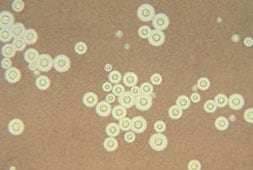
A photomicrograph of Cryptococcus neoformans using a light India ink staining preparation. Credit: CDC/ Dr. Leanor Haley.
Cryptococcosis is an infection caused by fungi that belong to the genus Cryptococcus. There are over 30 different species of Cryptococcus, but two species – Cryptococcus neoformans and Cryptococcus gattii – cause nearly all cryptococcal infections in humans and animals. Although many people who develop cryptococcosis have weakened immune systems, some are previously healthy.
C. neoformans can be found in soil throughout the world. People at risk can become infected after inhaling microscopic, airborne fungal spores. Sometimes these spores cause symptoms of a lung infection, but other times there are no symptoms at all. In people with weakened immune systems, the fungus can spread to other parts of the body and cause serious disease.
For other Fungal topics, visit the Fungal Homepage.
Cryptococcosis Topics
 Definition
Definition
What is Cryptococcosis?…
 Symptoms
Symptoms
Shortness of breath, cough, and fever…
 Risk & Prevention
Risk & Prevention
Who gets it and how it can be prevented…
 Causes
Causes
Inhalation of spores, contact with the skin…
 Diagnosis & Testing
Diagnosis & Testing
See your health care provider, sample tissue, clinical diagnosis…
 Treatment & Outcomes
Treatment & Outcomes
Antifungal treatment, mortality rate…
 Screening
Screening
Combating the global burden of cryptococcal meningitis
 Statistics
Statistics
Incidence, surveillance…
Spotlight
Cryptococcus in Persons Living with HIV
Cryptococcal meningitis is a leading cause of death among persons living with HIV/AIDS in sub-Saharan Africa. CDC is helping to start programs that will reduce the number of deaths from this infection. Until now, diagnosis and treatment guidelines have not been targeted at resource-limited countries. CDC has partnered with WHO and leading international experts to develop new guidelines [PDF - 44 pages] , which target the realities faced in resource-limited settings, and are the first to recommend screening for cryptococcal disease.
Contact Us:
- Centers for Disease Control and Prevention
1600 Clifton Rd
Atlanta, GA 30333 - 800-CDC-INFO
(800-232-4636)
TTY: (888) 232-6348 - Contact CDC–INFO
 ShareCompartir
ShareCompartir


